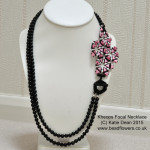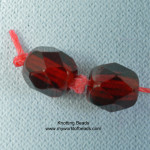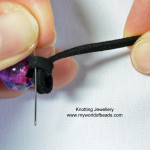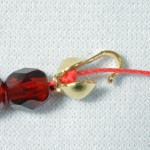Thread for Stringing Beads
If you want to just string beads, then you hav e a few options. This post looks at thread for stringing beads, but you may also be interested to read about Stranded Wire for creating professional jewellery. The first thing I want to point out is that the best thread for stringing beads is not necessarily the same as thread for bead-weaving. It is possible to use bead-weaving threads – I have done so on many occasions and I did so regularly when I first started out and didn’t know any better! However, this type of thread is so fine that you will want to make several passes through your beads in order to feel certain that the necklace or bracelet is secure. If you use a thread that is more suited to stringing beads then this will not be the case.
e a few options. This post looks at thread for stringing beads, but you may also be interested to read about Stranded Wire for creating professional jewellery. The first thing I want to point out is that the best thread for stringing beads is not necessarily the same as thread for bead-weaving. It is possible to use bead-weaving threads – I have done so on many occasions and I did so regularly when I first started out and didn’t know any better! However, this type of thread is so fine that you will want to make several passes through your beads in order to feel certain that the necklace or bracelet is secure. If you use a thread that is more suited to stringing beads then this will not be the case.
Choosing Thread for Stringing Beads
There are a few basic rules to bear in mind when you are choosing a thread for stringing beads: you want the end product to drape nicely, but you also want it to be strong. So, think about the beads you are planning to use: are they heavy or lightweight? Is the weight going to be spread evenly around the length of the jewellery, or centred in one place? If you are using heavy beads, then you need a very strong thread that will bear a lot of weight. However, heavy beads will also help to create a drape, so even if your threading material is less pliable, the weight of the beads will help it to drape more naturally. If you are using heavy beads, then you might want to consider a stranded wire rather than a thread. If your beads have rough holes, then you would be best to use a stranded wire.
 Secondly, how are you constructing your jewellery? Will you be knotting between the beads, for example in making a pearl necklace? Or will you just allow the beads to sit next to one another and only knot the clasp in place? Does the clasp have to be knotted in place or is there another method of fixing it? If you are going to be knotting anywhere at all in the construction, then you will need a thread, not a stranded wire. Stranded wires are fixed with crimps and there is another post that deals with this separately.
Secondly, how are you constructing your jewellery? Will you be knotting between the beads, for example in making a pearl necklace? Or will you just allow the beads to sit next to one another and only knot the clasp in place? Does the clasp have to be knotted in place or is there another method of fixing it? If you are going to be knotting anywhere at all in the construction, then you will need a thread, not a stranded wire. Stranded wires are fixed with crimps and there is another post that deals with this separately.
If you want to create stretch jewellery, then an elastic is the best option. This is easy to use: just cut a length a little longer than your finished item, thread on the beads and knot the ends of the elastic. I recommend using a little clear nail varnish or glue to seal the knot, then if you thread the ends through a neighbouring bead and pull, you should be able to bury the knot inside a bead so it doesn’t show. This makes very simple, quick jewellery and is great if you are looking for options for children.
So, let’s assume you’ve decided that thread is definitely the best option for you: what brands are available? Well, I commonly use S-Lon. This is a thicker thread: it will fit through the eye of a needle and, in addition to stringing, it can be used for bead-weaving, as well as Kumihimo. It is easy to knot and, as it is a fibre based nylon thread, it has no stretch, so you will find that your beads are held securely and you don’t get any gapping over time due to stretched thread. As with many other threads, this is available in different thicknesses, so if you are using a thicker cord, then you may find that it will not fit through a beading needle. If this is the case, then trim the end of the thread at an angle, coat the tip with clear nail varnish, and this will give you a toughened tip that will make it easier to string through beads. You could also look at using a heavier Fireline, particularly if you are stringing beads with small holes. If you are planning to string pearls, then I would recommend a silk thread as this is specifically designed for that purpose.
Firemountain Gems have put together a comprehensive table showing how different types of thread compare for weight and thickness, so this may be a useful resource if you are trying to decide what is best for your project. You can find it here.
Constructing Jewellery
Having chosen your thread, you might want some tips for constructing your jewe llery. I mentioned knotting between beads. This is a technique that is commonly used for creating pearl jewellery. It is designed to protect cultured pearls, so it’s not essential if you are using cheap pearls, but it does make for a professional necklace. The idea is that, by placing a knot between each pearl, the pearls are prevented from rubbing against one another as the necklace is worn and if the necklace should break, the knots should prevent all the pearls from falling off at once. You can find a guide to knotting here. You can also use knots to separate areas of beads or to create interest in a design.
llery. I mentioned knotting between beads. This is a technique that is commonly used for creating pearl jewellery. It is designed to protect cultured pearls, so it’s not essential if you are using cheap pearls, but it does make for a professional necklace. The idea is that, by placing a knot between each pearl, the pearls are prevented from rubbing against one another as the necklace is worn and if the necklace should break, the knots should prevent all the pearls from falling off at once. You can find a guide to knotting here. You can also use knots to separate areas of beads or to create interest in a design.
If you are not going to be knotting anywhere along the jewellery, then you will still need to find a way of attaching a clasp. It is perfectly possible to just sew through the eye on each half of the clasp finding, then finish the thread securely. However, you might want to consider a more professional finish. This type of beading cord or thread is perfect for finishing with a calotte: you can create a knot inside the calotte and attach this to the clasp. Again, it may be a good idea to seal your knot with a small dab of clear nail varnish or glue.
need to find a way of attaching a clasp. It is perfectly possible to just sew through the eye on each half of the clasp finding, then finish the thread securely. However, you might want to consider a more professional finish. This type of beading cord or thread is perfect for finishing with a calotte: you can create a knot inside the calotte and attach this to the clasp. Again, it may be a good idea to seal your knot with a small dab of clear nail varnish or glue.
Whatever you decide, you can find plenty of great tutorials and advice for different stringing techniques, so take a little time to familiarise yourself with the materials and the techniques and you will be making beautiful jewellery in no time!











I just ordered Hobby Lobby’s extra strong bonded nylon upholstery thread for my #8 and #11 seed beads. I plan on nothing more than single strand necklaces. It’s from SewOlogy . You recon that will be ok?
Hi Bob – it’s not a brand with which I am familiar. So, I can’t tell for sure. It sounds promising, but the best way to find out is to try it. You want to watch that it doesn’t fray or tangle badly. Usually, weak spots in thread (ie areas that might fall apart later) are caused by the thread splitting or fraying. Other than that, if it feels comfortable to use, go for it! I hope you enjoy your project.
Katie